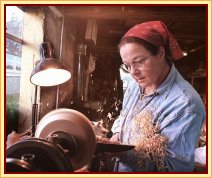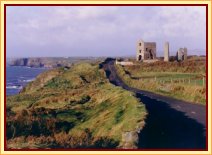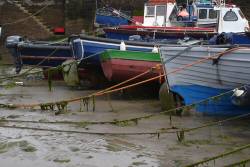 |
||
|
|
 Heather McDonald who, with her husband, Bruce, runs Waterford Woodcrafts, a centre for wood-turning located near Annestown
|
At this time of year the Copper Coast is a sequestered territory, traversed only by its native inhabitants and the few traders who call in the course of business. Even during the tourist season, the region is a quiet backwater, free from the excessive pressures associated with mass tourism. Yet, this 20-mile stretch of coastline between the Co Waterford towns of Tramore and Dungarvan is rich in natural attractions and historical curiosities. It has Blue Flag beaches, towering cliffs and sea-stacks, rivers and bog lands teeming with wildlife, and six small villages, each with their individual characteristics and charm. The local tourist committee has produced a modest brochure which commends the region's seclusion. "The whole area," it says, "is virtually unscarred by modern construction and lifestyle, giving (it) an unspoiled traditionally Irish ambience in both scenery and service alike." As its name suggests, the Copper Coast was not always quiet and unexploited. Gaunt buildings and the remains of giant chimneys and engine houses dotted along the cliffs are testimony to the intensive copper mining operations that took place in the 19th century. In 1824, some 1,500 people worked in the mines, with shafts reaching depths of a quarter of a mile and the same distance out under the sea-bed. Some older members of the declining local community can point to a direct family connection with the mining operations. Eileen Torpey, now aged 75, lives on a side road near the secluded little harbour of Boatstrand. Her cottage has no electricity. Her mother, who lived to be 98, would not have the ESB connected when the poles arrived in 1940, and Eileen has carried on that tradition - preferring her open fire and oil lamp, and listening to the news on a battery radio. Her grandfather worked in the nearby Bunmahon mines, and when those workings were abandoned he emigrated to the mining town of Butte, Montana - as did hundreds, perhaps thousands, of other Co Waterford and West Cork copper miners. Without employment from the mines, the local population declined steadily, and she has watched the inexorable change brought about by the inwards migration of a different generation. "It is all newcomers, coming in every day," she remarks. As elsewhere throughout Ireland, the growing popularity of walking holidays is bringing more people to explore the area, which is rich in historical content. The route brings them through the unique villages of Fenor, Annestown, Dunhill and Stradbally, and offers a range of unspoiled beaches and secluded swimming spots. © The Irish Times 1997 This article can also be found at The Irish Times
More information on the Copper Coast can be found at |


